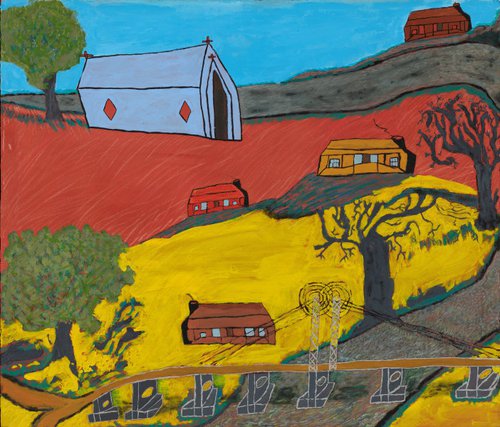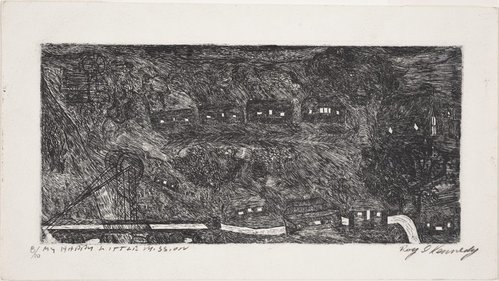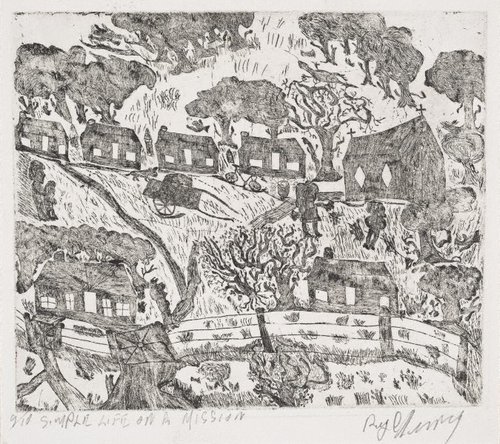Title
Mossgiel Weigh Station
2001
Artist
-
Details
- Place where the work was made
-
Sydney
→
New South Wales
→
Australia
- Date
- 2001
- Media category
- Materials used
- etching
- Edition
- 2/10
- Dimensions
- 12.3 x 20.2 cm platemark; 42.1 x 59.7 cm sheet
- Signature & date
Signed l.r. beneath platemark, pencil "Roy D Kennedy". Not dated.
- Credit
- Mollie Gowing Acquisition fund for Contemporary Aboriginal art 2001
- Location
- Not on display
- Accession number
- 449.2001
- Copyright
- © Roy Kennedy
- Artist information
-
 Roy Kennedy
Roy Kennedy
Works in the collection
- Share
-
-
About
Roy Kennedy, like many contemporary Aboriginal artists, came to art late in life. As he says, '... I'm living proof that you're never too old to learn.' Kennedy began studying painting and etching at the Eora Centre TAFE (Technical and Further Education) in Redfern, Sydney in 1995. Adult education centres such as Eora offer Aboriginal students the chance to catch up on the education denied them as children, and also to train in art making techniques. Many artists living and working in the city today, including Kennedy and fellow Eora Centre graduates H.J. Wedge and Elaine Russell, are using their newly acquired skills to reflect on their young lives on Aboriginal missions in rural Australia, Kennedy was born on the Police Paddock Mission at Darlington Point, near Griffith in New South Wales. In his intimately detailed views of the people and places of his childhood, Kennedy's strength of vision as an artist is revealed. 'Pepper Tree Avenue' was the arterial road leading to the mission from the highway. In 'Pepper Tree Avenue', 2001, Kennedy depicts the familiar landmarks of his childhood: the mulberry trees, the mission church – home of 'the brainwashers' and the Murrumbidgee River. Kennedy has said, '... Pepper Tree Avenue was on Warangesda Mission where my mother was born in 1910. This mission was closed down in 1925, so all my people were scattered everywhere. Eventually they were moved to the mission on the police paddock, [and] from there on all the old people were classed as fringe dwellers.'
Drawing on his mother's stories and his own experience, Kennedy's work documents a life of dislocation and deprivation, from the Depression years up until the abolition, in 1940, of the notorious Aborigines Protection Board that managed the missions in New South Wales. With the greater freedom that ensued, families often dispersed from the missions to find work in the surrounding agricultural communities. Kennedy recalls, '... wandering around doing seasonal work wherever and not finding any satisfaction with the rough life, not caring much about tomorrow.'
He worked as a ganger on the national railway and, like many young men, drifted towards the big city, seeking refuge in the growing metropolitan Aboriginal communities.
Kennedy's memories of mission life are bittersweet, underscored by the sense of community that saw his family through hard times. His 'Mission Series' prints chronicle his first-hand observations of a chapter of Australia's history that is finding increasing expression in the work of Indigenous artists.
Hetti Perkins in 'Tradition today: Indigenous art in Australia', Art Gallery of New South Wales, Sydney, 2004
© Art Gallery of New South Wales
-
Places
Where the work was made
Sydney
-
Exhibition history
Shown in 2 exhibitions
Country Culture Community (2008-09), Art Gallery of New South Wales, Sydney, 12 Nov 2008–19 Apr 2009
Murruwaygu: following in the footsteps of our ancestors, Art Gallery of New South Wales, Sydney, 28 Nov 2015–21 Feb 2016
-
Bibliography
Referenced in 3 publications
-
Craig Brush, Look: 1953-2003 celebrating 50 years, 'Reading for life: gallery launch for a new kid's book series', pg. 71, Sydney, May 2003, 71 (illus.).
-
Hetti Perkins, Tradition today: Indigenous art in Australia, 'Roy Kennedy', pg. 56, Sydney, 2004, 56 (illus.), 57 (illus., detail).
-
Warwick Reeder, Helen Kaptein and John Kean, Raw and compelling: Australian naïve art - the continuing tradition, Swan Hill, 2005, 27 (illus.). NOTE: this is not the AGNSW impression.
-




